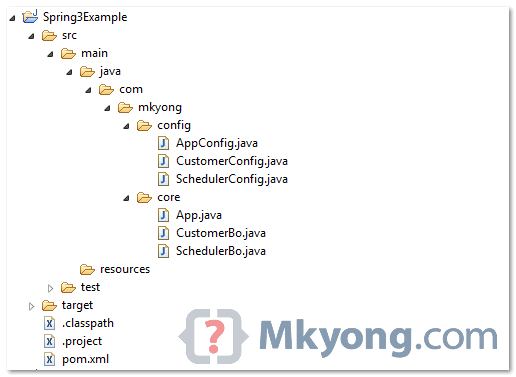Normally, you will split a large Spring XML bean files into multiple small files, group by module or category, to make things more maintainable and modular. For example,
<beans xmlns="http://www.springframework.org/schema/beans"
xmlns:xsi="http://www.w3.org/2001/XMLSchema-instance"
xsi:schemaLocation="http://www.springframework.org/schema/beans
http://www.springframework.org/schema/beans/spring-beans-2.5.xsd">
<import resource="config/customer.xml"/>
<import resource="config/scheduler.xml"/>
</beans>In Spring3 JavaConfig, the equivalent functionality is @Import.
package com.mkyong.config;
import org.springframework.context.annotation.Configuration;
import org.springframework.context.annotation.Import;
@Configuration
@Import({ CustomerConfig.class, SchedulerConfig.class })
public class AppConfig {
}@Import Example
See a full example of using JavaConfig @Import.
1. Directory Structure
Directory structure of this example.
2. Spring Beans
Two simple Spring beans.
File : CustomerBo.java
package com.mkyong.core;
public class CustomerBo {
public void printMsg(String msg) {
System.out.println("CustomerBo : " + msg);
}
}File : SchedulerBo.java
package com.mkyong.core;
public class SchedulerBo {
public void printMsg(String msg) {
System.out.println("SchedulerBo : " + msg);
}
}3. @Configuration example
Now, use JavaConfig @Configuration to declare above beans.
File : CustomerConfig.java
package com.mkyong.config;
import org.springframework.context.annotation.Bean;
import org.springframework.context.annotation.Configuration;
import com.mkyong.core.CustomerBo;
@Configuration
public class CustomerConfig {
@Bean(name="customer")
public CustomerBo customerBo(){
return new CustomerBo();
}
}File : SchedulerConfig.java
package com.mkyong.config;
import org.springframework.context.annotation.Bean;
import org.springframework.context.annotation.Configuration;
import com.mkyong.core.SchedulerBo;
@Configuration
public class SchedulerConfig {
@Bean(name="scheduler")
public SchedulerBo suchedulerBo(){
return new SchedulerBo();
}
}4. @Import example
Use @Import to load multiple configuration files.
File : AppConfig.java
package com.mkyong.config;
import org.springframework.context.annotation.Configuration;
import org.springframework.context.annotation.Import;
@Configuration
@Import({ CustomerConfig.class, SchedulerConfig.class })
public class AppConfig {
}5. Run it
Load the main configuration file , and test it.
package com.mkyong.core;
import org.springframework.context.ApplicationContext;
import org.springframework.context.annotation.AnnotationConfigApplicationContext;
import com.mkyong.config.AppConfig;
public class App {
public static void main(String[] args) {
ApplicationContext context = new AnnotationConfigApplicationContext(
AppConfig.class);
CustomerBo customer = (CustomerBo) context.getBean("customer");
customer.printMsg("Hello 1");
SchedulerBo scheduler = (SchedulerBo) context.getBean("scheduler");
scheduler.printMsg("Hello 2");
}
}Output
CustomerBo : Hello 1
SchedulerBo : Hello 2




















 2万+
2万+











 被折叠的 条评论
为什么被折叠?
被折叠的 条评论
为什么被折叠?








